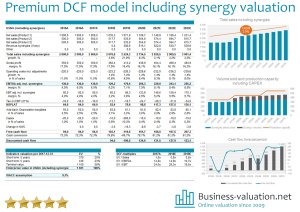
Mergers & Acquisitions (M&A) Models Start the discussion!

What is 'Mergers and Acquisitions' (M&A)
Consolidating companies or assets is generally referred to as ‘Mergers and Acquisitions.’ It is a kind of an umbrella term for a range of transactions, such as Mergers or Acquisitions (obviously), asset purchases, tender offers, and management acquisitions. Every single case involves two companies. ‘M&A’ as a term also refers to the department with a financial company that deals with all Mergers and Acquisitions.
Breaking Down Mergers & Acquisitions
As aforementioned, ‘M&A’ can include various transactions. These are:
Merger: The result of this is the elimination of one company as it becomes a part of another company. This happens after the Boards of Directors of each company approve the combination of the two companies and seek the shareholders’ approval. You could also think of it like an ‘absorption’ of one company by another.
Acquisition: In this case, the acquiring company will obtain the majority stake of another firm. The acquired firm will keep its own name and legal structure.
Consolidation: The result of this transaction is the creation of a brand new company. It is necessary that each company’s stakeholders approve the consolidation, and once this is done, they will receive common equity shares in the newly created firm.
Tender Offer: Here, one company buys the outstanding stock of another company at a set price. The offer is communicated directly to the target company’s shareholders, without prior agreement from the management or board of directors. The acquiring company may still exist after the transaction, however the majority of tender offers end up becoming mergers.
Acquisition of Assets: When a company buys another company’s assets, it acquires them from that company. The approval of shareholders must be obtained before the company’s assets can be acquired. This is common in cases of bankruptcy, where other firms will aim to buy the assets of a bankrupt company during a bid. The bankrupt company will be liquidated when all of their assets have been acquired.
Management Acquisition: This refers to when a company’s executives buy a controlling stake of another company, enabling it to become private. It is common that these former executives will form a partnership with former corporate officers or a financier to aid the funding of the transaction. This type of transaction will usually be financed partly with debt, and it’s necessary that it is approved by the majority of shareholders.
What's the Difference Between a Merger and an Acquisition?
A merger is when two separate companies, generally of a similar size, will come together to create a new company in which both entities will become equal partners.
An acquisition is when one company buys another separate company. This is generally a bigger company buying a smaller company. Unlike a merger, a new company is not formed by this type of acquisition. Rather, the acquired company will cease to exist, and the acquiring company will take over its assets. If the target firm resists being taken over, there can be very negative connotations surrounding the deal, often instead referred to as a ‘takeover.’ Because of this, even if two companies are going through an acquisition, they’ll refer to it as a merger to avoid any negative press.
In legal terms, for a merger to take place, you need two companies that will consolidate into a new legal entity with a new management structure and new ownership. For an acquisition to take place, one company will take over all managerial operational decisions of another company.
Realistically, it is uncommon that friendly ‘mergers of equals’ take place in which two companies will come together to create a new, better company. Generally, the benefit isn’t clear, and the CEOs are rarely 100% keen on sacrificing authority to realize potential benefits. However when it does take place, both companies surrender stocks and new stocks will be issued under the identity of the new business.
Because mergers aren’t common and takeovers are surrounded by negative connotations, the two terms have become more and more combined and used in accordance with one another. In a more modern environment, corporate restructurings are referred to as M&A transactions rather than a merger or an acquisition. The differences between the two are becoming less and less recognized. How the purchase is relayed to the public is becoming increasingly important, as something seen as potentially hostile can be hugely damaging to the acquiring company’s reputation.
To read more on Mergers & Acquisitions visit:
Most popular Models
 A Premium Discounted Cash Flow DCF Model including synergy valuation12,5443add_shopping_cart$49.00
A Premium Discounted Cash Flow DCF Model including synergy valuation12,5443add_shopping_cart$49.00
 by Patrik Johansson
by Patrik Johansson

Acquisition Excel Model
A model to help plan and determine outcomes of acquiring different businesses4,9899add_shopping_cart$10.00 by Evan Diaz de Arce
by Evan Diaz de Arce

M&A Buy-Side Target Screening Nine-Box Matrix - PowerPoint & Excel Model
A 9-box and 4 quadrant matrix template for M&A Target Screening, editable in Microsoft PowerPoint.4,9062add_shopping_cart$7.00
 by Tim Demoures
by Tim Demoures

Acquisition Process: Detailled Overview, Timeline and Keys to Success
BEST PRACTICE ACQUISITIONS: Details for each step and Tips for Success + Complimentary expert answer to Your Question1,853Discussadd_shopping_cart$9.00 by Rositsa Yancheva
by Rositsa Yancheva

P&L Due Diligence - Exhaustive Revenue Analysis model
Model for in depth understanding of high level P&L and Revenue Analysis. Big-4 like book of due diligence analyses.1,758Discussadd_shopping_cart$199.00 by HEURTEBIZE
by HEURTEBIZE

Complete Private Equity Model
Complete financial model for valuing, forecasting, and acquiring companies in the form of private equity investments.4,403Discussadd_shopping_cart$89.00 by DW Financial Services
by DW Financial Services








